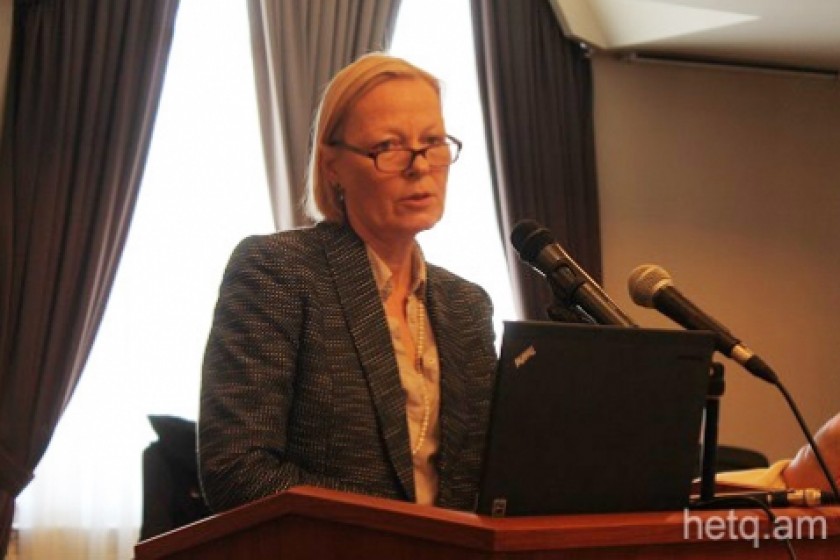
UNICEF Rep in Armenia Pushes Flawed PR Regarding Enriched Flour Initiative
Marine Martirosyan
Vahe Sarukhanyan
Manja Henriette Ahrens, who heads the UNICEF office in Armenia, is so intent to publicize the enriched flour project sponsored by her organization in a positive light, that sometimes, to put it mildly, she gets caught in sticky situations.
At the end of last year, with backing from UNICEF, Armenia’s Ministry of Health organized a seminar for reporters on enriched flour. During her presentation regarding the supposed benefits of enriched flour for Armenia, Manja Henriette Ahrens offered the example of iodized salt.
“Armenia already has a similar successful experience, that of the obligatory iodization of salt. This project has greatly resolved the problem of the population’s lack of iodine,” Ms. Ahrens stated.
In other words, Ms. Ahrens is convinced that enriched flour, like iodized salt, will resolve all existing problems. In reality, however, was the iodized salt project actually as successful as she declared?
We should point out that the iodized salt project was also carried out with assistance from UNICEF. In 2004, the Armenian government adopted a project to “Combat and Prevent the Consequences of Inadequate Iodine in the Diet of Armenia’s Population”.
A year later, as part of the Armenian government’s demographic and health study of families in the country, it was revealed that 97% of the households examined were already using iodized salt.
The 2005 study, conducted by UNICEF, Armenia’s Ministry of Health and the International Committee for the Control of Iodine Deficiency Disorders, revealed that in children of school age in Armenia the problem of iodine deficiency had disappeared. After all this, in 2006 the UNICEF representative in Armenia filed a certificate with the Ministry of Health recognizing Armenia as a country that had overcome its iodine deficiency issue.
In reality, however, having iodized salt on the kitchen table does not mean that family members are getting the iodine they need because when food is cooked the iodine in the salt added to the meal escapes. Thus, health experts advise that the salt be added after the food is warmed up. Iodine also escapes when it is kept in open conditions (3-4 months) and in closed conditions (after one year).
Before citing the iodized salt example as a successful project Ms. Ahrens would do well to pay particular attention to children suffering from congenital hypothyroidism and overall statistics related to the disorder in general in Armenia.
|
Hypothyroidism often called underactive thyroid or low thyroid and sometimes hypothyreosis, is a common endocrine disorder in which the thyroid gland does not produce enough thyroid hormone. It can cause a number of symptoms, such as tiredness, poor ability to tolerate cold, and weight gain. In children, hypothyroidism leads to delays in growth and intellectual development. Hypothyroidism is caused by inadequate function of the gland itself (primary hypothyroidism) or by not enough stimulation by thyroid-stimulating hormone (central hypothyroidism). Primary hypothyroidism is about a thousand fold more common than central hypothyroidism. Iodine deficiency is the most common cause of primary hypothyroidism and endemic goiter worldwide. |
Hetq wrote to the Ministry of Health asking how many cases of hypothyroidism had been registered in the country between 2003 and 2014. We also requested that the ministry provide us with statistics on screenings for congenital hypothyroidism conducted as of 2005.
The ministry provided us with registered hypothyroidism cases in Armenia between 2004 and 2013. Below is a graph of the total numbers, by year, and in relative terms (per 100,000 people).
Interestingly enough, the largest number of hyperthyroidism patients was registered in 2006, the year when UNICEF certified that Armenia had won the battle against iodine deficiency. In addition, to the consternation of Ms. Ahrens’ much ballyhooed “successful” example of mandatory iodization, the number of patients has continued to rise since 2010.
Screening for congenital hyperthyroidism is conducted at Yerevan’s Arabkir Medical Center- Institute of Child and Adolescent Health. Republican Party MP Ara Babloyan, President of the Armenian National Assembly’s Standing Committee on Health Care, Maternity and Childhood, founded the complex and serves as its scientific director. The former director of the Center was his son Sergey. Another son Arman, who served as deputy minister of health from 2013-2015, is the current director. Below are the screening statistics presented by Arman Babloyan.
|
Year |
Number of Screenings/Studies |
Newborns Diagnosed with Congenital Hyperthyroidism |
|
2005 |
2.331 |
0 |
|
2006 |
11.365 |
4 |
|
2007 |
22.192 |
4 |
|
2008 |
23.676 |
8 |
|
2009 |
27.729 |
8 |
|
2010 |
26.544 |
14 |
|
2011 |
35.042 |
7 |
|
2012 |
38.682 |
15 |
|
2013 |
39.922 |
16 |
|
2014 |
45.465 |
15 |
As shown, the number of patients has increased concurrent with an increase in screenings.
Given the above, UNICEF’s representative in Armenia appears to be promoting an enriched flour program based on little more than demagoguery.
 Videos
Videos Photos
Photos
Comments (5)
Write a comment